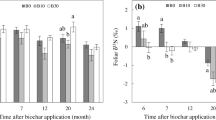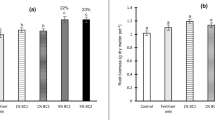Abstract
Background and aim
Biochar application to soil is widely claimed to increase plant productivity. However, the underlying mechanisms are still not conclusively described. Here, we aim to elucidate these mechanisms using stable isotope probing.
Methods
We conducted two experiments with uniquely double-labelled (15N and 13C) biochar and its feedstock (residue), applied separately at 15 Mg ha−1. Both experiments contained three treatments: biochar amendment (Biochar), unpyrolysed residue amendment (Residue) and a no addition control (Control). Experiment I was a 119 day pot experiment seeded with Lolium perenne. Experiment II was a 71 day incubation experiment without plants in which CO2 and N2O fluxes were measured.
Results
Both Biochar and Residue significantly increased aboveground productivity compared to Control (140% and 160%, respectively). Initial N immobilisation was stimulated in Residue, whereas not in Biochar. 13C–CO2 analysis confirmed that biochar was significantly more recalcitrant than residue. 15N analysis showed that 2% and 0.3% of grass N was derived from the amended material in Residue and Biochar, respectively.
Conclusions
Our results suggest that biochar-induced yield increases derive from a combination of reduced N immobilization and a moderate N fertilization effect. Although in the short term biochar might offer benefits compared to residue incorporation, it is unlikely that biochar yield gains will be sustainable for the decades to centuries that biochar C can be expected to reside in soil.





Similar content being viewed by others
References
Balota E, Colozzi-Filho A, Andrade D, Dick R (2003) Microbial biomass in soils under different tillage and crop rotation systems. Biol Fertil Soils 38:15–20. doi:10.1007/s00374-003-0590-9
Bedard-Haughn A, van Groenigen JW, van Kessel C (2003) Tracing 15N through landscapes: potential uses and precautions. J Hydrol 272:175–190. doi:10.1016/S0022-1694(02)00263-9
Bligh EG, Dyer WJ (1959) A rapid method for total lipid extraction and purification. Can J Biochem Physiol 37:911–917
Boschker HTS (2004) Linking microbial community structure and functioning: Stable isotope (13C) labeling in combination with PLFA analysis. In: Kowalchuk GA, Head d BFJIM, Akkermans AD and van Elsas JD (ed) Molecular microbial ecology manual II. Kluwer, pp 1673–1688
Boschker JT, Nold SC, Wellsbury P, Bos D, de Graaf W, Pel R, Parkes RJ, Cappenberg TE (1998) Direct linking of microbial populations to specific biogeochemical processes by 13C-labelling of biomarkers. Nature 392:801–805. doi:10.1038/33900
Bossio DA, Scow KM (1998) Impacts of carbon and flooding on soil microbial communities: phospholipid fatty acid profiles and substrate utilization patterns. Microb Ecol 35:265–278. doi:10.1007/s002489900082
Bromand S, Whalen J, Janzen HH, Schjoerring J, Ellert BH (2001) A pulse-labelling method to generate 13C- enriched plant materials. Plant Soil 235:253–257. doi:10.1023/A:1011922103323
Case SDC, McNamara NP, Reay DS, Stott AW, Grant HK, Whitaker J (2015) Biochar suppresses N2O emissions while maintaining N availability in a sandy loam soil. Soil Biol Biochem 81:178–185. doi:10.1016/j.soilbio.2014.11.012
Cayuela ML, Sánchez-Monedero MA, Roig A, Hanley K, Enders A, Lehmann J (2013) Biochar and denitrification in soils: when, how much and why does biochar reduce N2O emissions? Sci Rep 3:1732. doi:10.1038/srep01732
Cayuela ML, van Zwieten L, Singh BP, Jeffery S, Roig A, Sánchez-Monedero MA (2014) Biochar's role in mitigating soil nitrous oxide emissions: a review and meta-analysis. Agric Ecosyst Environ 191:5–16. doi:10.1016/j.agee.2013.10.009
Clough TJ, Bertrama JE, Raya JL, Condron LM, O'Callaghan M, Sherlock RR, Wells NS (2010) Unweathered wood biochar impact on nitrous oxide emissions from a bovine-urine-amended pasture soil. Soil Sci Soc Am J 74:852–860. doi:10.2136/sssaj2009.0185
Clough T, Condron L, Kammann C, Müller C (2013) A review of biochar and soil nitrogen dynamics. Agronomy 3:275–293. doi:10.3390/agronomy3020275
Cornelissen G, Gustafsson O, Bucheli TD, Jonker MTO, Koelmans AA, van Noort PCM (2005) Extensive sorption of organic compounds to black carbon, coal, and kerogen in sediments and soils: mechanisms and consequences for distribution, bioaccumulation, and biodegradation. Environ Sci Technol 39:6881–6895. doi:10.1021/es050191b
Craine JM, Morrow C, Fierer N (2007) Microbial nitrogen limitation increases decomposition. Ecology 88:2105–2113. doi:10.1890/06-1847.1
Crombie K, Mašek O, Cross A, Sohi S (2015) Biochar – synergies and trade-offs between soil enhancing properties and C sequestration potential. GCB Bioenergy 7:1161–1175. doi:10.1111/gcbb.12213
Frostegård A, Bååth E (1996) The use of phospholipid fatty acid analysis to estimate bacterial and fungal biomass in soil. Biol Fertil Soils 22:59–65. doi:10.1007/BF00384433
Gurwick NP, Moore LA, Kelly C, Elias P (2013) A systematic review of biochar research, with a focus on its stability in situ and its promise as a climate mitigation strategy. PLoS One 8:e75932. doi:10.1371/journal.pone.0075932
Hodgson EM et al (2011) Variation in Miscanthus chemical composition and implications for conversion by pyrolysis and thermo-chemical bio-refining for fuels and chemicals. Bioresour Technol 102:3411–3418. doi:10.1016/j.biortech.2010.10.017
Jeffery S, Verheijen FGA, van der Velde M, Bastos AC (2011) A quantitative review of the effects of biochar application to soils on crop productivity using meta-analysis. Agric Ecosyst Environ 144:175–187. doi:10.1016/j.agee.2011.08.015
Jeffery S, Abalos D, Spokas K, Verheijen FGA (2015a) Biochar effects on crop yields. In: Lehmann J, Joseph S (eds) Biochar for environmental management: science, technology and implementation. Earthscan, London, pp 301–326
Jeffery S, Bezemer TM, Cornelissen G, Kuyper TW, Lehmann J, Mommer L, Sohi SP, van de Voorde TFJ, Wardle DA, van Groenigen JW (2015b) The way forward in biochar research: targeting trade-offs between the potential wins. GCB Bioenergy 7:1–13. doi:10.1111/gcbb.12132
Karaosmanoǧlu F, Işıḡıgür-Ergüdenler A, Sever A (2000) Biochar from the straw-stalk of rapeseed plant. Energy Fuel 14:336–339. doi:10.1021/ef9901138
Lee KH, Jose S (2003) Soil respiration, fine root production, and microbial biomass in cottonwood and loblolly pine plantations along a nitrogen fertilization gradient. For Ecol Manag 185:263–273. doi:10.1016/S0378-1127(03)00164-6
Lehmann J, Gaunt J and Rondon M 2006 Bio-char sequestration in terrestrial ecosystems – A Review. 11, 395–419 DOI:10.1007/s11027-005-9006-5
Liu X, Zhang A, Ji C, Joseph S, Bian R, Li L, Pan G, Paz-Ferreiro J (2013) Biochar’s effect on crop productivity and the dependence on experimental conditions—a meta-analysis of literature data. Plant Soil 373:583–594. doi:10.1007/s11104-013-1806-x
Maestrini B, Nannipieri P, Abiven S (2014) A meta-analysis on pyrogenic organic matter induced priming effect. GCB Bioenergy 7:577–590. doi:10.1111/gcbb.12194
Mia S, van Groenigen JW, van de Voorde TFJ, Oram NJ, Bezemer TM, Mommer L, Jeffery S (2014) Biochar application rate affects biological nitrogen fixation in red clover conditional on potassium availability. Agric Ecosyst Environ 191:83–91. doi:10.1016/j.agee.2014.03.011
Mukherjee A, Lal R (2014) The biochar dilemma. Soil Research 52:217–230. doi:10.1071/SR13359
Nelissen V, Rütting T, Huygens D, Ruysschaert G, Boeckx P (2015) Temporal evolution of biochar's impact on soil nitrogen processes – a 15N tracing study. GCB Bioenergy 7:635–645. doi:10.1111/gcbb.12156
Olsson PA, Bååth E, Jakobsen I, Söderström B (1995) The use of phospholipid and neutral lipid fatty acids to estimate biomass of arbuscular mycorrhizal fungi in soil. Mycol Res 99:623–629. doi:10.1016/S0953-7562(09)80723-5
Oram NJ, van de Voorde TFJ, Ouwehand GA, Bezemer TM, Mommer L, Jeffery S, Van Groenigen JW (2014) Soil amendment with biochar increases the competitive ability of legumes via increased potassium availability. Agric Ecosyst Environ 191:92–98. doi:10.1016/j.agee.2014.03.031
Paul EA, Paustian KH, Elliott ET, Cole CV (1996) Soil organic matter in temperate Agroecosystems - long term experiments in North America. CRC Press, Taylor Francis Group, USA
Prendergast-Miller MT, Duvall M, Sohi SP (2014) Biochar–root interactions are mediated by biochar nutrient content and impacts on soil nutrient availability. Eur J Soil Sci 65:173–185. doi:10.1111/ejss.12079
Sagrilo E, Jeffery S, Hoffland E, Kuyper TW (2015) Emission of CO2 from biochar-amended soils and implications for soil organic carbon. GCB Bioenergy 7:1294–1304. doi:10.1111/gcbb.12234
Sánchez-García M, Roig A, Sanchez-Monedero MA, Cayuela ML (2014) Biochar increases soil N2O emissions produced by nitrification-mediated pathways. Front Environ Sci 2:25. doi:10.3389/fenvs.2014.00025
Shackley S, Sohi SP, Ibarrola R, Hammond J, Mašek O, Brownsort P, Cross A, Prendergast-Miller M, Haszeldine S (2012) Biochar, tool for climate change mitigation and soil management. In: Lenton T, Vaughan N (eds) Geoengineering responses to climate change. Springer, New York, pp 73–140
Singla A, Iwasa H, Inubushi K (2014) Effect of biogas digested slurry based-biochar and digested liquid on N2O, CO2 flux and crop yield for three continuous cropping cycles of komatsuna (Brassica rapa var. perviridis). Biol Fertil Soils 50:1201–1209. doi:10.1007/s00374-014-0950-7
Spokas KA, Cantrell KB, Novak JM, Archer DW, Ippolito JA, Collins HP, Boateng AA, Lima IM, Lamb MC, McAloon AJ, Lentz RD, Nichols KA (2012) Biochar: a synthesis of its agronomic impact beyond carbon sequestration. J Environ Qual 41:973–989. doi:10.2134/jeq2011.0069
Stark JM, Hart SC (1996) Diffusion technique for preparing salt solutions, Kjeldahl digests, and persulfate digests for nitrogen-15 analysis. Soil Sci Soc Am J 60:1846–1855
Stiboka (1975) Stiboka Bodemkaart van Nederland Stiboka, Wageningen, The Netherlands
Suddick EC, Six J (2013) An estimation of annual nitrous oxide emissions and soil quality following the amendment of high temperature walnut shell biochar and compost to a small scale vegetable crop rotation. Sci Total Environ 465:298–307. doi:10.1016/j.scitotenv.2013.01.094
Tilman D, Cassman KG, Matson PA, Naylor R, Polasky S (2002) Agricultural sustainability and intensive production practices. Nature 418:671–677. doi:10.1038/nature01014
Van de Voorde TFJ, Bezemer TM, Van Groenigen JW, Jeffery S, Mommer L (2014) Soil biochar amendment in a nature restoration area: effects on plant productivity and community composition. Ecol Appl 24:1167–1177. doi:10.1890/13-0578.1
Vance E, Brookes P, Jenkinson D (1987) An extraction method for measuring soil microbial biomass C. Soil Biol Biochem 19:703–707
Velthof GL, Kuikman PJ, Oenema O (2002) Nitrous oxide emissions from soils amended with crop residues. Nutr Cycl Agroecosyst 62:249–261. doi:10.1023/A:1021259107244
von Rein I, Gessler A, Premke K, Keitel C, Ulrich A, Kayler ZE (2016) Forest understory plant and soil microbial response to an experimentally induced drought and heat-pulse event: the importance of maintaining the continuum. Glob Chang Biol 22:2861–2874. doi:10.1111/gcb.13270
Wardle D A, Nilsson M C, Zackrisson O (2008) Fire-Derived Charcoal Causes Loss of Forest Humus. Science 320, 629. doi:10.1126/science.1154960
Warnock D, Lehmann J, Kuyper T, Rillig M (2007) Mycorrhizal responses to biochar in soil – concepts and mechanisms. Plant Soil 300:9–20. doi:10.1007/s11104-007-9391-5
Woolf D, Amonette JE, Street-Perrott FA, Lehmann J, Joseph S (2010) Sustainable biochar to mitigate global climate change. Nat Commun 1:56. doi:10.1038/ncomms1053
Yoo G, Kang H (2012) Effects of biochar addition on greenhouse gas emissions and microbial responses in a short-term laboratory experiment. J Environ Qual 41:1193–1202. doi:10.2134/jeq2011.0157
Zelles (1999) Fatty acid patterns of phospholipids and lipopolysaccharides in the characterisation of microbial communities in soil: a review. Biol Fertil Soils 29. doi:10.1007/s003740050533
Zhang QZ, Dijkstra FA, Liu XR, Wang YD, Huang J, Lu N (2014) Effects of biochar on soil microbial biomass after four years of consecutive application in the North China plain. PLoS One 9:e102062. doi:10.1371/journal.pone.0102062
Zheng J, Stewart CE, Cortufo MF (2012) Biochar and nitrogen fertilizer alters soil nitrogen dynamics and greenhouse gas fluxes from two temperate soils. J Environ Qual 41:1361–1370. doi:10.2134/jeq2012.0019
Zimmerman A R, Gao B, Ahn MY (2011) Positive and negative carbon mineralization priming effects among a variety of biochar-amended soils. Soil Biology and Biochemistry, 43, 1169–1179
Acknowledgements
We gratefully acknowledge funding support from the Marie Curie Career Integration Grant (No. GA526/09/1762) and funding from the Emerging Science fund of the Production Ecology and Resource Conservation (PE&RC) graduate school of Wageningen UR, Netherlands. We are also grateful for the assistance of André Maassen for watering plants, and Jaap Nelemans and Willeke van Tintelen for technical assistance in the laboratory and Ana Prada for assistance with formatting.
Author information
Authors and Affiliations
Corresponding author
Additional information
Responsible Editor: Erik J. Joner.
Rights and permissions
About this article
Cite this article
Jeffery, S., Memelink, I., Hodgson, E. et al. Initial biochar effects on plant productivity derive from N fertilization. Plant Soil 415, 435–448 (2017). https://doi.org/10.1007/s11104-016-3171-z
Received:
Accepted:
Published:
Issue Date:
DOI: https://doi.org/10.1007/s11104-016-3171-z




